The insects discussed in this article are sporadic pests of Florida citrus and may be found on many alternate hosts in or near citrus plantings. These pests rarely need treatment with pesticides unless populations become excessive due to weather conditions or pesticide upsets. Where treatment is necessary, growers should apply only spot treatment of infested areas.
Eastern Lubber Grasshopper - Romalea microptera (Beauv.)
The eastern lubber grasshopper is one of the larger native pest grasshoppers capable of causing defoliation of particularly young citrus trees in Florida in the summer. The adult is brilliant yellow with red and black markings, and is approximately 2 inches long. The nymphs are almost solid black with yellow and, occasionally, red markings (Figure 1). The nymphal stages will consume greater amounts of vegetation than the mature adults. The adult has relatively short wings and are incapable of flight. Greater insect populations are generally found along the borders of a citrus planting after migration from adjacent native forest or other vegetation areas. The life cycle is similar to other grasshopper species. The female lays her eggs in the soil generally in wet areas. Eggs require several weeks to develop.
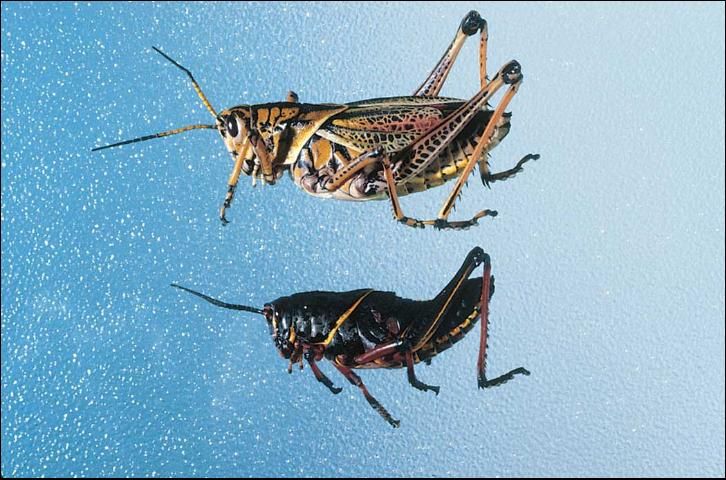
Credit: UF/IFAS CREC
American Grasshopper - Schistocerca americana (Drury)
The American or bird grasshopper is light brown with black markings on the wings and abdomen. It is approximately 2.5 inches long (Figure 2). Nymphal stages feed on the leaves and stems of citrus trees, causing extensive defoliation when populations reach high numbers. The adult grasshopper is able to fly over 50 feet in each flight. The female lays up to 100 eggs beneath the soil surface with nymphal emergence in the spring and fall. The first instar is green with subsequent stages highly variable in color and markings. This insect has five to six instars which develop over a 2-month time period. Late nymphal stages consume significantly more vegetation than the adults.

Credit: UF/IFAS CREC
Broadwinged Katydid - Microcentrum rhombifolium (Sauss.)
The broadwinged katydid is bright green, approximately 2 to 2.5 inches long with long slender legs which allow it to jump when disturbed (Figure 3). Wings are vertically oriented and are longer than the body. Several generations occur each year with the largest population occurring during June through September. Katydids feed on the foliage and can defoliate young trees, but usually do not cause extensive damage. They may also feed on citrus fruit, causing large, smooth, and/or sunken areas on the developing fruit.
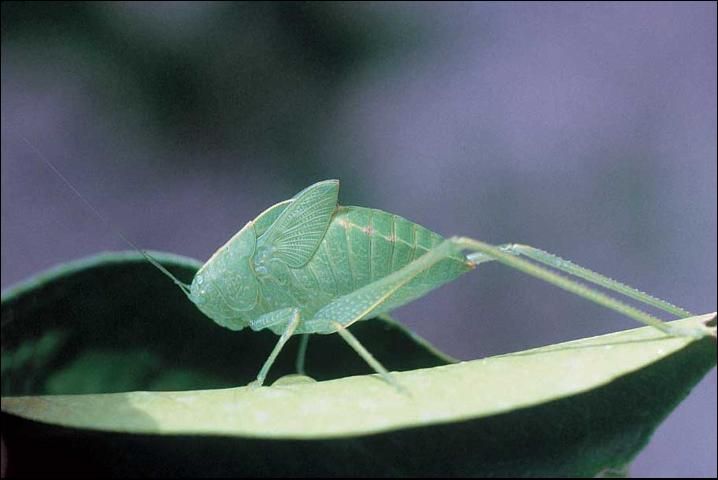
Credit: UF/IFAS CREC
Katydid eggs are brown to gray in color. The eggs are laid in a row along the leaf margin or slightly inserted in the edge of the leaf and are easily identified (Figure 4).
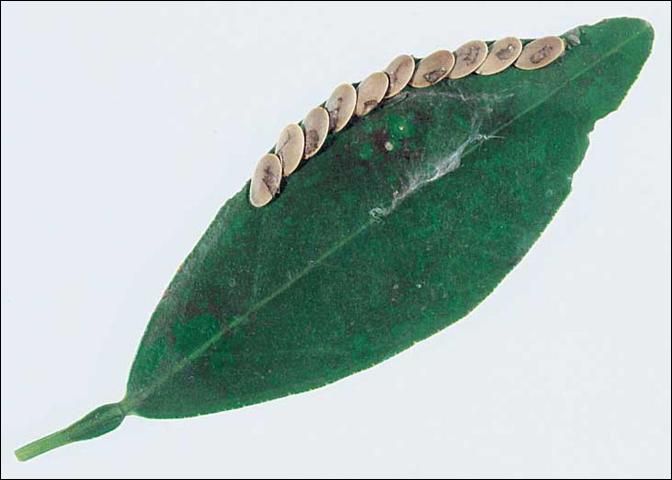
Credit: UF/IFAS CREC
Crickets - Hapihus agitator Uhler, Orocharis luteolira Walker
Both cricket species are dark brown to black and about one inch in length (Figure 5). The restless bush cricket (Hapihus agitator) and the false jumping bush cricket (Orocharis luteolira) can cause foliage and fruit damage to the peel before the fruit reaches an inch in diameter. When the fruit is larger, crickets will cause abrasion to the peel (Figure 6). The extent of peel blemish depends on the extent of the feeding and age of the fruit. Extensive feeding can cause fruit drop. Leaf feeding injury is characterized by holes in the center of the leaves and along the leaf margin. Crickets will also feed on young twigs.

Credit: UF/IFAS CREC
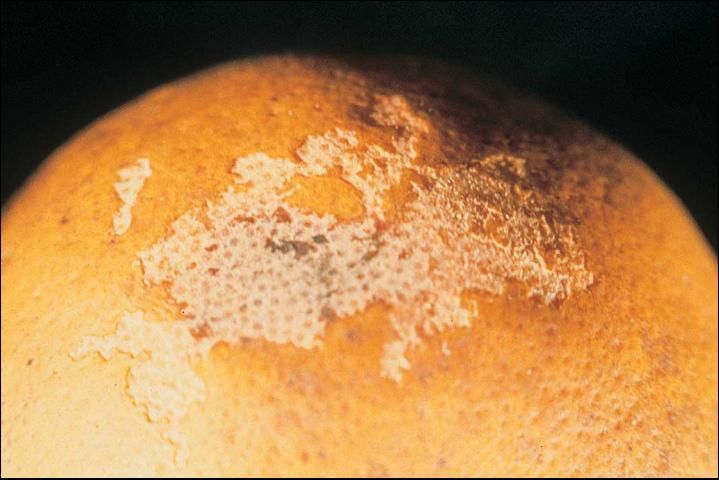
Credit: UF/IFAS CREC
Leaf-Footed Bug - Leptoglossus phyllopus (L.)
The adult leaf-footed bug is dark brown with a yellow band across the body (Figure 7). It is less than one inch long and oval in shape. The hind legs have an enlarged tibia. They are strong fliers moving readily from host plant to host plant. They pierce the fruit with their piercing, sucking mouthparts. Their puncture of the fruit rind allows decay organisms to enter the fruit leading to subsequent rot. Insect feeding will result in a premature color break and fruit drop. The immature bugs will develop on many non-citrus host plants, maturing in the fall and winter at which time they begin to feed on citrus.
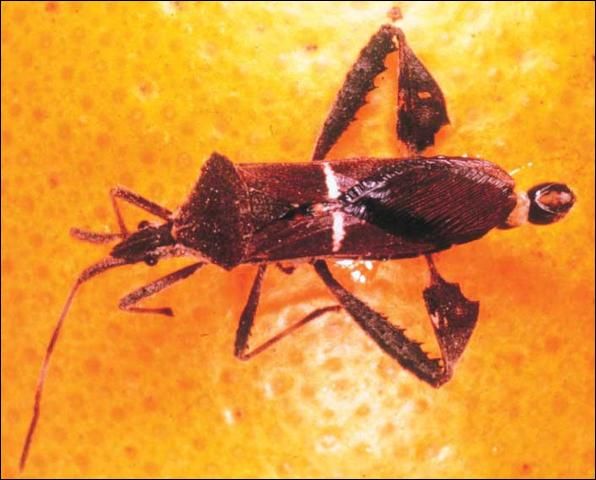
Credit: UF/IFAS CREC
Southern Green Stinkbug - Nezara viridula (L.)
The southern green stink bug is bright green with a broadly oval shield-shaped body (Figure 8). The adult female is approximately one-half inch long, the male being slightly smaller. Stink bugs rarely develop on citrus. Populations are usually highest during October-December and March-April. Damage to the fruit is a result of piercing the peel with piercing-sucking mouthparts. Subsequent damage results in a darkened scar and may cause fruit drop. When the damaged area of the fruit is peeled, a discolored and dry area often appears in the flesh below the damaged area.
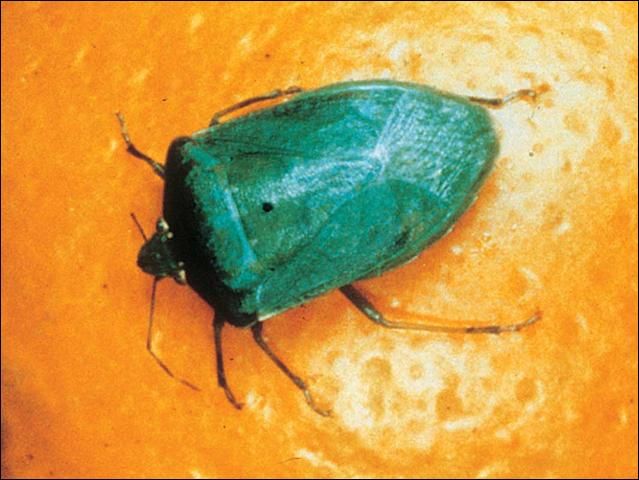
Credit: UF/IFAS CREC
Orangedog - Papilio cresphontes (Cramer)
The larva of the swallowtail butterfly (orangedog) will feed on the foliage of young citrus trees and can cause extensive damage and defoliation. The larval stage is a brown and white caterpillar which resembles bird droppings. It is approximately 1 to 2 inches in length (Figure 9). Several orangedog larvae can completely defoliate a small one-year-old citrus tree in a few days. The adult swallowtail butterfly has velvet black wings with two rows of yellow spots along the margin of the wings (Figure 10) and is native to the southeastern United States. The adult swallowtail butterfly can lay as many as 500 round eggs, which are dull orange-cream in color, on tender citrus leaves. These eggs are laid individually as the female moves from plant to plant. The larvae feed on young leaves at the margin and increase foliage consumption as they increase in size. When the larvae are disturbed, they will eject an orange forked structure (osmetrium) just behind the head capsule which can exude a pungent aroma which deters predators.
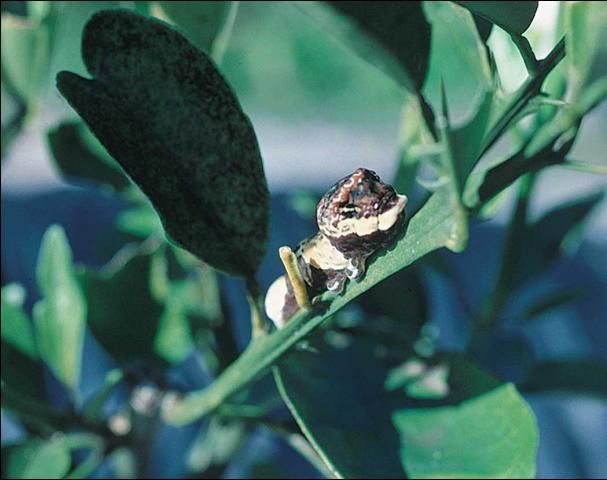
Credit: UF/IFAS CREC
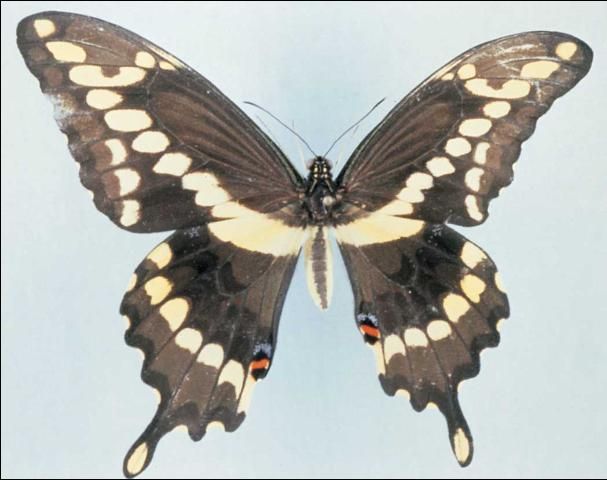
Credit: UF/IFAS CREC
Citrus Leafminer - Phyllocnistis citrella Stainton
Adults are minute moths, having a one-fourth inch wingspread. The forewings are covered with white and silvery iridescent scales, with several black and tan markings, and a black spot on each wingtip (Figure 11). This pest is native to Asia and first appeared in Florida in 1993.
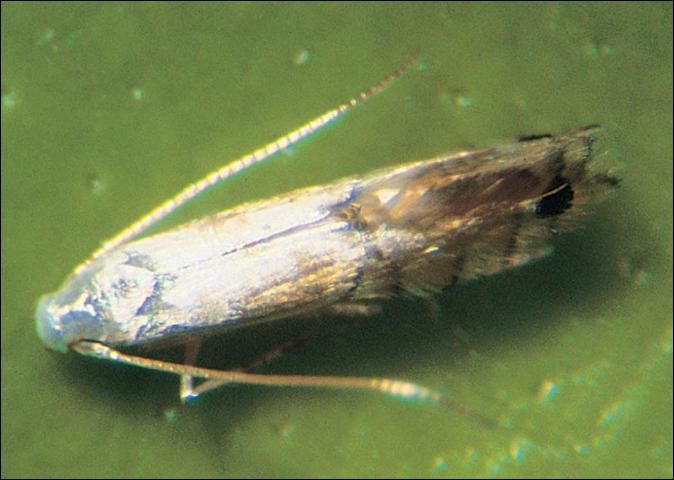
Credit: UF/IFAS CREC
Adults emerge about dawn and are active in the morning, late afternoon and at night. Females lay eggs in the evening, and at night.
Translucent eggs are laid individually on the under side or upper surface of newly developed leaves or green twigs. Upon entering the leaf, the larva begins to feed, producing a serpentine larval mine in the leaf surface and rarely penetrates deep into the leaf (Figure 12). Larvae are minute, up to one-fourth inch long, translucent greenish yellow and located inside the leaf mine. Leaf mines can be present on both the upper and lower leaf surfaces. As the larvae mature, they move toward the leaf margin creating a pupation chamber at the leaf edge. Damage includes the mining of the leaf results in leaf distortion, leaf drop, possible stem dieback, and has been shown to promote infection levels of citrus canker. Citrus leafminers will also feed on fruit, but generally this feeding is not a significant problem.
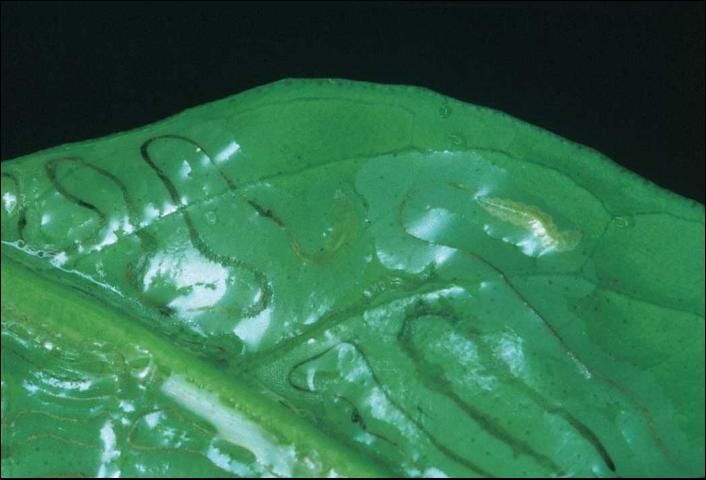
Credit: UF/IFAS CREC
For more information on identification of insect pests, you may wish to consult the annual Florida Citrus Production Guide published by the University of Florida Institute of Food and Agricultural Sciences, Gainesville, Florida.